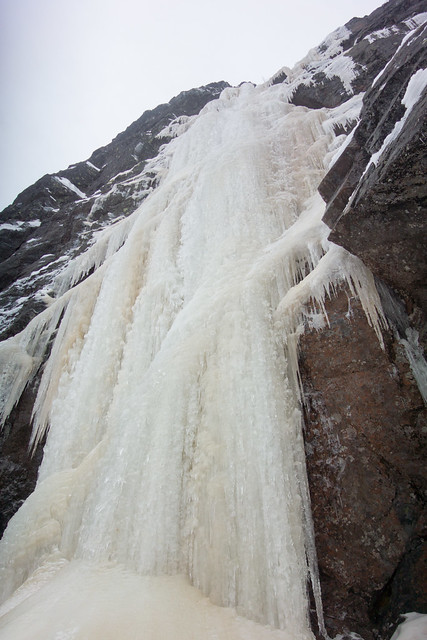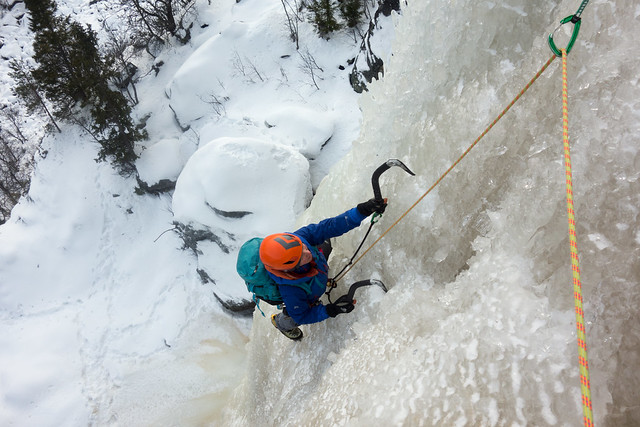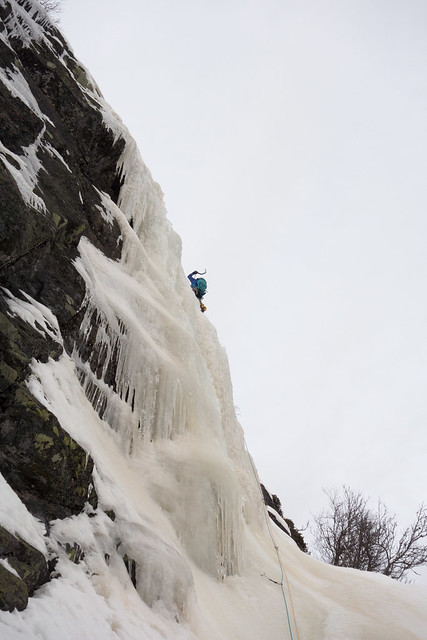After a big day on Makalu the previous day, there was certainly enough reason for Nikolay, Anna and myself to return to Stavadalen in order to take advantage of some decent ice conditions. Some of the routes at Stavadalen were a little on the thin side but O'hoi looked fat and enticing, although apparently not as fat as it can be some years. It was both shorter and potentially easier than Makalu and, with no rising traverses to negotiate, it was hopefully more predictable. Some friends had also climbed the route the day before, which further reduced the uncertainties. Anna had climbed the route the previous season but she was more than happy to climb it again, given Stavadalen's close proximity to our cabin and the poor alternatives elsewhere, such as in Hemsedal. The route's name apparently originates from the first ascentionists who needed rescuing, and apparently shouted 'o'hoi' in the dark in order to gain attention.
 |
| O'hoi (WI4, 100m) |
I was now largely over the flu that had affected me either side of New Year, which was good for the psyche, although I was a little apprehensive about leading the crux first pitch after having felt so pumped on Makalu the previous day. I'm not very good at surrendering crux pitches though and so I challenged for the first pitch regardless with Nikolay with paper-scissors-stone. Winning that focused the psyche a little more, as though it was somehow now fate that I should lead the crux. My rough plan though was to try and make a belay at approximately midway between the ground and an obvious ramp at about 3/4 height so that we would both get a decent share of the leading.
A lot of the ice low down was steep, chandeliered, and intimating, but an obvious line of weakness followed the general right side, via some friendlier features. The climbing still looked steep, but there was none of the trashed bleached white ice on the surface that we had experienced on Makalu, which certainly raised my optimism.
 |
| View from the base of the route |
I started via an easy rightward leading ramp, with airy ice that wasn't great to protect. With height gained the climbing became progressively steeper, but with better ice. Despite the good features the ice was sill brittle, which meant a lot of dinner-plating ice. Additionally there was a little paranoia about encountering loose dinner plates that our friends from yesterday might have left as a present. Particularly after a conversation the previous night with regards how it was better to leave fractured ice in place rather than tumble it.
About midway up the pitch there came a definite crux up a steep wall, which was a good test for me. The straight-up nature of the climbing was pumpy, but simpler incremental footwork, made it easier for me to stay in shape compared to the awkward traverse on Makalu the day before. I also had my fifi hook tucked down my top and so felt fairly confident knowing I could easily clip to an axe if the pump became too uncontrollable. Towards the top of the difficulties a glove managed to clip itself to my ice clipper, which only added to the pump as I tried to free it using the best combination of calmness and urgency that I could muster.
 |
| Me leading the first pitch (Photo by Anna Kennedy) |
My arms still felt a little pumped once I was off the steepest ground but I could afford to take my time a little more, now that the weight was primarily on my feet. I reached an abalakov thread and gladly clipped a quickdraw to it.
I made a belay after only 30m, as there was already a shallow platform of sorts to rest my forefeet on, plus the spot was also protected by a shallow roof. The ground above me looked slabbier and probably less comfortable for a team of three, and maybe more exposed to ice fall, and so the slightly premature belay looked the sensible option. I was probably leaving Nikolay a longer but easier pitch, which seemed a pair split. The general group verdict though was that my belay stance sucked and for sure it was a good calf burner that instigated a lot of fidgeting and repositioning of feet.
 |
| Nikolay seconding the first pitch |
 |
| Anna approaching the belay on the first pitch |
Nikolay's second pitch started and finished steeply, but was overall a more steady affair, with nothing overly sustained. That brought us to the top of the large sloping ledge, which oddly had bolt rings at the belay.
 |
| Nikolay starting the second pitch (photo by Anna Kennedy) |
From here Anna led the final pitch, firstly up the gentle ramp, before regaining steeper ground, where it formed a vague open corner. Anna disappeared from sight, then reappeared on the skyline at midheight, only to dissappear from view again.
 |
| Anna leading the third pitch |
We jointly reached the top shortly before sunset to cap a couple of successful days climbing in Stavadalen. A short abseil brought us back to the bolt rings, from where we were able to make a long second abseil all the way to the ground with 60m ropes. By this point we were greated to the type of spectacular pink sunset one rarely sees outside the winter months.
 |
| Abseiling the route at sunset (photo by Anna Kennedy) |
The presence of the bolt rings was a mystery, given there is so much ice to make abalakov threads. It's the sort of thing I expect in Cogne but but not in Norway. Maybe bolts were placed during the rescue that followed the first ascent and for some reason they have been maintained. They were certainly too new to date back to the first ascent and were surely placed more recently.
Gradewise, the pitches felt like 4+, 4 and 4, and therefore slightly easier than Makalu, which felt like WI5 in current conditions. It was tough for its listed WI4 in current conditions. Despite possibly climbing the best two routes in Stavadalen in consecutive days there definitely seems good reason to return during another season when some of the other routes are in fatter condition. The secluded setting, short approaches, with long routes is an excellent combination.









Comments
Post a Comment